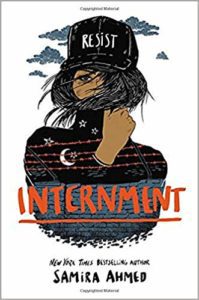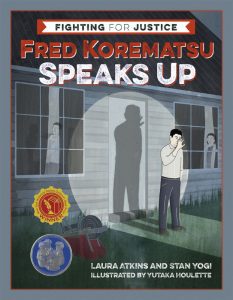An American Story of Oppression and Resistance: Samira Ahmed’s Internment
From time to time, we see new YA novels that everyone seems to be reading and discussing. Angie Thomas’s The Hate U Give — a testimonial novel that captured killings of unarmed Black teenagers and the rise of Black Lives Matter — was one of them. Two years into the new administration, with its Muslim travel ban and family separations and mass detentions along the southern border of the United States, Samira Ahmed’s Internment has captured the cultural zeitgeist.
Although Internment is classified as dystopian, set in the near future rather than the present like The Hate U Give, Ahmed, author of the acclaimed contemporary novel Love, Hate & Other Filters, draws on both historical events and current trends. Like Love, Hate & Other Filters, Internment addresses Islamophobia and the stereotyping and demonization of Muslim Americans. But she takes it one step further, imagining a hate-filled, tweeting President who whips up fear against the Other to gain popular support, eliminate enemies, and impose a repressive regime with book burnings, curfews, and soldiers patrolling the streets. Her dystopian United States draws primarily from Hitler’s Nuremberg Laws which forced Jews in Germany to register and banned them from government jobs and schools, the internment of Japanese Americans during the Second World War, and the White Rose resistance of young people against the Nazi regime. An author’s note at the end offers a bibliography of resources about the Japanese-American internment, and in the story itself the young Muslim resisters inside the camp discuss the work of Sophie Scholl and the White Rose.
 The novel begins with a book burning of Muslim-authored and other works deemed by the President and his new Secretary of War as subversive. Seventeen-year-old Layla Amin is not at this mandatory community event in her small college town in Southern California but with her Jewish boyfriend David as curfew nears. Missing curfew, she and David must dodge armed militia to get home safely, but when Layla returns home, her problems are far from over. Later that night, soldiers from the Exclusion Force come to take Layla and her family to an internment camp in the northern California desert, not far from the ruins of the Manzanar camp where tens of thousands of Japanese Americans were once held. Inside the camp, Layla pledges not to adjust to her new routine and circumstances, but to smuggle out blog posts to David with the help of a sympathetic camp guard. And as allies gather outside the electrified fence to demand the camp’s closing and an end to the repression, Layla reaches across ethnic and racial lines to coordinate nonviolent resistance to the regime embodied by the camp’s sadistic Director.
The novel begins with a book burning of Muslim-authored and other works deemed by the President and his new Secretary of War as subversive. Seventeen-year-old Layla Amin is not at this mandatory community event in her small college town in Southern California but with her Jewish boyfriend David as curfew nears. Missing curfew, she and David must dodge armed militia to get home safely, but when Layla returns home, her problems are far from over. Later that night, soldiers from the Exclusion Force come to take Layla and her family to an internment camp in the northern California desert, not far from the ruins of the Manzanar camp where tens of thousands of Japanese Americans were once held. Inside the camp, Layla pledges not to adjust to her new routine and circumstances, but to smuggle out blog posts to David with the help of a sympathetic camp guard. And as allies gather outside the electrified fence to demand the camp’s closing and an end to the repression, Layla reaches across ethnic and racial lines to coordinate nonviolent resistance to the regime embodied by the camp’s sadistic Director.
Because I’m a student of history and a writer of fiction with international settings, I read Internment from that perspective. And I found the novel to be a story rooted in a U.S. experience — what one might call an American story except that “America” encompasses many nations from North, Central, and South America with very different cultures and histories. In its narrative structure, the options that the protagonist and her family consider, the way the the conflict is resolved, and the selection of historical details to include, Internment reflects the author’s belonging to a culturally diverse, democratic, and capitalist nation and her embracing of its values.
 Like most novels in its category, Internment is narrated from the point of view of a single individual and roughly follows the hero’s journey from the known world into an unfamiliar and perilous world full of challenges, enemies, and allies (some of those allies in unexpected places) and then back to the known world. At first glance, Layla seems an unlikely leader of a resistance movement, for all she wants to do is spend time with her boyfriend and keep her stressed-out parents (stressed out because her professor father has lost his job, his books are being burned, and her chiropractor mother is losing patients) off her back. In the camp, however, this only child is the one who reaches out to other teenagers to build the resistance movement under the Director’s nose. And while Layla represents the archetype of the Hero, the author quickly identifies the Director as the villain, overtaking the cruelty and sadism of a distant President, his Secretary of War, and the townspeople who fall for his propaganda. There are no additional point of view characters, and while Layla has many helpers, she’s the one who calls the shots. In contrast, for instance, Kip Wilson’s Sophie Scholl, the protagonist of White Rose, is clearly not the leader of the movement but joins her older brother Hans and his friends later on when she enrolls at the university in Munich. She argues with her brother and his friends, and often expresses impatience with his treatment of her as a subordinate, but she continues to play her role, one resister among many.
Like most novels in its category, Internment is narrated from the point of view of a single individual and roughly follows the hero’s journey from the known world into an unfamiliar and perilous world full of challenges, enemies, and allies (some of those allies in unexpected places) and then back to the known world. At first glance, Layla seems an unlikely leader of a resistance movement, for all she wants to do is spend time with her boyfriend and keep her stressed-out parents (stressed out because her professor father has lost his job, his books are being burned, and her chiropractor mother is losing patients) off her back. In the camp, however, this only child is the one who reaches out to other teenagers to build the resistance movement under the Director’s nose. And while Layla represents the archetype of the Hero, the author quickly identifies the Director as the villain, overtaking the cruelty and sadism of a distant President, his Secretary of War, and the townspeople who fall for his propaganda. There are no additional point of view characters, and while Layla has many helpers, she’s the one who calls the shots. In contrast, for instance, Kip Wilson’s Sophie Scholl, the protagonist of White Rose, is clearly not the leader of the movement but joins her older brother Hans and his friends later on when she enrolls at the university in Munich. She argues with her brother and his friends, and often expresses impatience with his treatment of her as a subordinate, but she continues to play her role, one resister among many.
A second way that Internment is an “American” story is in the options that Layla and her family consider. Once they’ve registered as Muslim in the census, they can only wait and hope that there will be no further consequences. What they do not do is pack their bags, what my father-in-law did when Hitler’s Nuremberg Laws forced him to register as Jewish and expelled him from law school. Germany and many other European nations are “nations of emigration and immigration,” with long histories of population movement from country to country within the continent, from the continent to distant lands, and from former colonies and war-torn nations into the continent. The United States, in contrast, has been the destination of immigrants from elsewhere without significant movement in the other direction. While that may one day change (and in fact, the numbers of people moving from the U.S. to Mexico currently exceeds the number of Mexicans moving to the U.S.), the idea of emigration for either economic opportunity or political freedom is not on the radar of most people in the U.S. It is not on the Amin’s radar, the possibility so remote that desi (South Asian American) Layla knows no other language besides English. As a result, once the hammer falls, she and her family have no other choices except to submit or to resist.
Boundless optimism and the faith that effort equals success and one person can change the world is another way that this is an “American” story. To some extent, this ties into the structure of the young adult novel, which is supposed to leave the reader with hope even when the ending is short of happy. I would say more about this, but Internment is new enough that I don’t want to spoil the ending for those of you who haven’t read it because it’s a powerful, thrilling page-turner of a novel with a lot to offer both teen and adult readers. Suffice to say that the YA novel is itself a U.S. creation now being exported all over the world, while many novels published abroad that feature teenage characters have a hard time breaking into the U.S. market or if they are translated, are published as adult literary fiction where endings can be more ambiguous or despairing.

A highly recommended recent book about the Japanese-American internment during World War II.
Finally, Internment lets capitalism off the hook in a way that doesn’t reflect the reality of racism and xenophobia in prisons and immigrant detention centers today, instead, reinforcing the belief that big government is not usually a good thing and private enterprise lies at the center of the nation’s greatness. The sadistic Director and those who have placed him in his position are all part of the government, the public sector. We do not see companies profiting from the internment camp, either in its construction, which is more of a military effort, or in its administration. In contrast to the Nazi concentration camps, slavery and Jim Crow prison farms, and today’s prison industrial complex, internees don’t manufacture goods for corporations to sell at a huge profit. Instead, and to some extent like the Japanese-American internment camps (though internees there and POWs were in fact farmed out to private companies and agricultural enterprises), the camp in Internment is designed to be self-sustaining, with the internees growing their own food and setting up schools and libraries. In that sense, the reality is worse than what the novel portrays. In Internment, free enterprise serves as a kind of ally when the blog posts and demonstrations garner high ratings, and, defying government censorship, media coverage undermines the entire internment program.
Ahmed has authored Internment as both a warning of what can happen if current trends are allowed to continue and as a guide for those resisting those trends. In an afterword, she writes, “Fascism isn’t going to simply appear in America one day. It’s here. But so are we.” Her story is an American story. Ironically, the troops carting Muslim Americans to the camps and guarding them is called the Exclusion Force; yet, every character, scene, and line in Internment tells readers how much Muslim Americans truly belong.







As usual, Lyn, I enjoyed your review. What I wonder about the book is that the author seems to have used a US-centered story that features “democratic capitalism,” which lets the corporations off the hook in a way that’s not the reality in the US. The corporate structure is not and has never been democratic. Rather, it’s a structure that’s controlled from the top with the workers at the bottom.
Real democracy has safeguards that thwart dictatorships or authoritarianism when fascists attempt to take over. Both Mussolini and Salazar—and later, Pinochet—used the term, “corporatism” for “fascism.” Another term, “neoliberalism,” which many confuse with liberal democracy, is economist Milton Friedman’s term for unfettered corporatism. When fascism takes over, it’s because democracy has been overthrown, not because capitalism has been weakened.
Good points, Beverly! We’re currently in a vicious cycle of rising corporate power and weakened democracy, as exemplified by the Citizens United and McCutcheon decisions of the Supreme Court. Corporate leaders, for the most part, fear democracy and universal suffrage because workers are the majority and all things being fair and equal will vote for policies leading to higher wages, better working conditions, and progressive taxation. Social issues and the exploitation of racial, ethnic, and religious divisions are a tried-and-true method of maintaining the power of the few against the many, and powerful private interests have too often abetted the kind of mass hatred that Ahmed portrays in Internment for their own ends.
Great review, Lyn. I also appreciate Beverly’s comment.
This quote is very telling: “Fascism isn’t going to simply appear in America one day. It’s here.”
टिप्पणी *wonderful words and impressive style congratulations